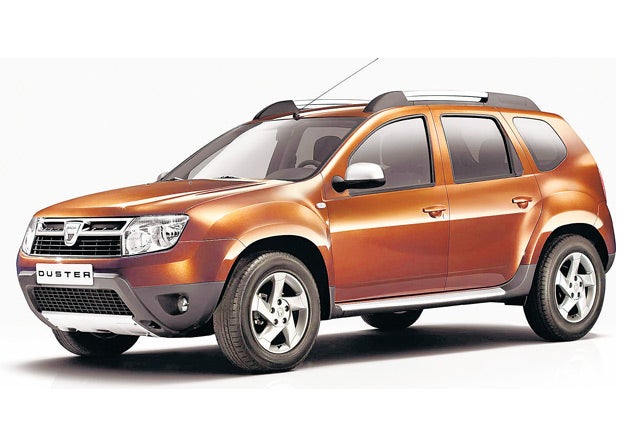Dacia Duster
If Ned Ludd were seeking a car, he might go for this

Your support helps us to tell the story
From reproductive rights to climate change to Big Tech, The Independent is on the ground when the story is developing. Whether it's investigating the financials of Elon Musk's pro-Trump PAC or producing our latest documentary, 'The A Word', which shines a light on the American women fighting for reproductive rights, we know how important it is to parse out the facts from the messaging.
At such a critical moment in US history, we need reporters on the ground. Your donation allows us to keep sending journalists to speak to both sides of the story.
The Independent is trusted by Americans across the entire political spectrum. And unlike many other quality news outlets, we choose not to lock Americans out of our reporting and analysis with paywalls. We believe quality journalism should be available to everyone, paid for by those who can afford it.
Your support makes all the difference.Sometimes I worry that I'm becoming a Luddite. New cars are loaded with ever more technology intended to make our driving lives easier, although it often has unforeseen and undesirable side-effects. Electric parking brakes that scupper uphill parking manoeuvres? Stereos that won't do as they are told? Automatic wipers which don't wipe when they should? Parking sensors whose beeps cause the radio to go quiet just when the news headlines are being broadcast? You get the idea.
One of the reasons I like classic cars is they do what you tell them when you tell them, and they don't try to second-guess your intentions. You're in control, and you don't have to develop strategies to fox the electronic tripwires. You are not welcomed on board by an electronic screen message, and you have the joy of inserting an ignition key and turning it. Ned Ludd would have loved that.
Please welcome heartily, then, the Dacia Duster. The Romanian Dacia company used to build previous-generation Renaults under licence, and I remember seeing a bunch of Romanians, post-Ceausescu, plundering every dead Renault 12 in my local scrapyard for pieces to fit their Dacia remake. Nowadays Renault owns the entire operation, which builds simple, low-cost cars of unique Dacia design but with Renault-derived parts. The Logan saloon and Sandero hatch are very popular in Eastern Europe and many developing-world markets.
The Duster is a new compact SUV, which is hardly a groundbreaking concept until you realise that it costs about the same as a typical supermini. Like the other Dacias it is based on the previous-generation Clio's underpinnings, in this case strengthened and optionally available with Nissan-engineered four-wheel drive. A good base for a Luddite-pleasing car.
There has been a Dacia Duster before, a crude off-roader sold in the 1980s and of which, according to Practical Classics magazine, just two survive in the UK. But this is a proper job, and will be available here in 2012, by which time Dusters will be raising dirt-road dust from Brazil to Siberia. Will it be worth the wait? Or will buyers be so brainwashed into the "need" for techno-gimmickry by then that the Duster will be doomed?
The Laureate top version of Duster will cost around £13,000, though the range will start at about £10,000. A quick tour gives strong clues as to where the money has been saved. Even the top-but-one Laureate trim level of the car tested here has simple painted metal for its boot sill, rear seats whose folding bases reveal their foam filling when folded, no reach adjustment for the steering wheel, and no automatic continuation of the electric windows' movement after one firm stab of the button. Much like my own Peugeot 205 GTI, then.
The electric window and mirror controls are on the centre console (it saves tooling up for separate left-hand and right-hand drive parts), the radio is a separate unit like something from an accessory shop, and hard plastic abounds. Once over the shock of such bare-faced functionalism in a new car, it feels oddly liberating. Besides, the dashboard looks perfectly modern, the exterior styling likewise and the seats are very comfortable and, yes, it does have air-con and central locking.
There are three Renault-sourced engines: a 105bhp, 1.6-litre petrol unit and a pair of 1.5-litre turbodiesels of 85 or 107bhp. This last is fitted to our front-wheel drive test car, which proves lively and rather more refined than you might expect. The gearbox – with an extravagant six gears – has a particularly short, neat shift action.
There's a suppleness to the ride that's a joy in a world of jittery new cars on unsuitably big wheels and firm springs, yet the tallish Duster doesn't flop over when taking corners. The only trade-off is the somewhat vague steering, but you get used to it.
Here's a compact SUV standing as a courageous antidote to overspecified, overpriced rivals. It has all the equipment you could reasonably need and it costs the same as a Clio. Drive a Duster, and suddenly the world seems easier to understand.
The rivals
Kia Soul 1.6 CRDi: from £14,000.
Looks like a 4x4 but isn't. Urban survival-module looks have an appeal, diesel engine is excellent.
Skoda Yeti 1.2 TSI: from £13,990.
Cheapest Yeti uses small but turbocharged petrol engine. Well made, fun to drive, ride is firm.
Toyota Urban Cruiser 1.4 D-4D: £17,050.
Curious city car-cum-4x4, that looks quite cute but is far too expensive, so no one buys it.
Join our commenting forum
Join thought-provoking conversations, follow other Independent readers and see their replies
Comments